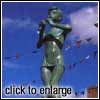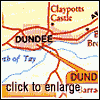|
Around Dundee
Following the coastal route through Monifieth, Barrie
Mill, signposted off to the left, is a restored and working flour-mill. Carnoustie,
further on, is best known for its Championship golf course, on the itinerary of most
serious golfers. With the Open returning in 1999, this magnificent but demanding
course is again firmly in favour. There are two other fine courses upon the links,
the Burnside and Buddon. A golf driving range can be found in town but ask locals
for directions as it is rather out of the way.
Arbroath
There are pleasant walks along the beach here and
a leisure centre that offers indoor sports. The A92 coast road north arrives in the
fishing and holiday town of Arbroath, a major centre for the county of Angus. Arbroath's
most famous landmark is its 12th century abbey founded by William the Lion. It was
from here that the famous Declaration of Arbroath was issued in 1320 asserting Robert
the Bruce as King of Scotland. This event crowned the bitter struggle for independence
from England, began by William Wallace in the late 1200's, gave a brief respite but
did not end it.
In later years, Reformation, once again, brought vandalism
and neglect to the Abbey of Arbroath. Stones were taken to construct many of the
older buildings that you see in Arbroath today, although interesting portions survive
such as the south transept and massively proportioned front entrance. There is a
small museum occupying the Abbot's House.
 Arbroath, as a fishing centre, became renowned for its sail-canvas
and even more famous for Smokies or smoked haddock, found in nearly forty fishmongers
or curing houses around the front where the process of smoking can still be observed.
The hot cure method, a traditional technique using kilns or 'smoke barrels' results
in a cooked, smoked fish that can be eaten hot or cold. Arbroath, as a fishing centre, became renowned for its sail-canvas
and even more famous for Smokies or smoked haddock, found in nearly forty fishmongers
or curing houses around the front where the process of smoking can still be observed.
The hot cure method, a traditional technique using kilns or 'smoke barrels' results
in a cooked, smoked fish that can be eaten hot or cold.
For fish of the battered variety, queues regularly
form along the sandstone tenement walls at the front in anticipation of a fish supper
from Peppo's, one of the most popular fish and chip shops in Scotland. The harbour
is a focus of activity in Arbroath even if it is just to sit and eat a steaming 'poke'
of fish and chips.
Along the West Links Promenade you will find the inspiration
for many childhood memories of a holiday in Arbroath, the miniature railway. Everything
is to scale, tiny sheds, miniature signals and dwarf bridges. Kerr's Miniature Railway
has been running for over half a century and has not changed much in that time. Next
to the diminutive train station is the terminus for the miniature bus or fire engine.
Next to the harbour is the Signal Tower, now a museum
and art gallery with display on fishing, the flax industry and natural history. The
building was a former signalling station for the Bell Rock or Inchcape Lighthouse
which, on a clear day, can be seen 12 miles (19km) out in the mouth of the Tay.
It is possible to walk along the tops of the Arbroath
Cliffs, known as Seaton Cliffs, to the little fishing cove of Auchmithie. These cocoa-coloured
precipices are older than 350 million years and many sea-birds can be seen especially
fulmar, gannet and the occasional puffin, fishing off-shore. The cliffs are unfenced
and can be dangerous if you stray off the path. It is a 6 mile (10km) walk there
and back and the path becomes rather confused on reaching the wooded glade near Auchmithie
where you can find yourself wading through cornfields.
Auchmithie is equally accessible by road and said
to be the first home of the Smokie. It is perched on a rugged headland above a wide,
pebble beach and ancient harbour. The 'But and Ben' restaurant serves some of the
tastiest local dishes such as a smoked haddock pancake done in a cream sauce or,
for a really traditional dish, try their 'tatties, mince and skirly'.
Coming out of Arbroath, there is a turning left, off
the A92, through a modern housing estate and down to a fascinating little hamlet
called St Vigeans. St Vigeans is quite unlike the other farming villages in these
parts, especially in its architecture. Its centre-piece is a small, red sandstone
church perched on a steep knoll, the site dating from the twelfth century or earlier.
There is a distinctive row of cottages surrounding
the knoll and one has been converted into a miniature museum. Here, the remains of
a large collection of Pictish standing stones are housed. Many of the original stones
were incorporated as building materials for the church and surrounding cottages and
others are sadly mutilated. The Drosten Stone is the most notable, a carved cross-slab
of the ninth century with animals, birds and a hooded archer carved in relief.
Back on the coast, the fine, wide sands of Lunan Bay
make an ideal escape. Watching over the sands is Redcastle, a lonely, ruined fortification
of the twelfth century, first built by King William the Lion as a royal hunting seat
to protect the coast from marauding Danish pirates. It can be explored by climbing
the steep path from the beach or there is easier access from the minor coastal road
behind the castle.
Montrose
The mouth of River South Esk at Montrose is one of
the most important sites in Britain for wintering wildfowl. Each winter sees over
12,000 pinkfeet and 2,000 greylag geese roosting in the basin after spending the
day feeding on nearby farm-land. There are several hides around the basin. From the
car park at Mains of Dun, off the A935, follow a track to two hides or from the car
park at the north-east corner on A935 there is a hide 500 yards to the south. A warden
naturalist may be available.
The town of Montrose is a curious combination of the
maritime and rustic. The oil industry of the last 25 years has brought benefits while
the rich surrounding farm-land has always been a reason for the burgh's wealth. There
is a large medieval market square in the middle of the main street. The seafront
is a major attraction with a wide beach and coastal links providing space and plenty
fresh air for recreation or relaxation. There are football fields, play parks and
two 18-hole golf courses. Tennis is available on courts in the town and there is
a nearby public swimming pool and fitness centre.
Three miles (5km) west of Montrose on the A936 is
the House of Dun, one of the most original houses designed by William Adam. A rather
severe, Palladian house surrounded by a beautiful garden and out-buildings, the house
is now run by National Trust for Scotland who have done an admirable job in restoring
it from a fairly dilapidated state. The exhilarating eighteenth-century plaster-work
found in the Saloon is a particular tribute to the restorer's talent as well as that
of the original craftsmen.
Brechin
Brechin is an important town in this strongly agricultural
interior region of Angus. The surrounding Vale of Strathmore is one of Scotland's
most productive farming belts.
Visitors come to see the cathedral and tower situated
on the banks above the South Esk along Chanonry Wynd. The tower, dating from AD990
is one of only two such round towers in Scotland, the other being at Abernethy in
Perthshire. Supposedly, these towers were constructed to offer protection during
Viking raids.
The library in St Ninian's Square is also the local
museum with information on the cathedral and tower as well as details of industry
and archaeology around the area. On the outskirts of town is the Brechin Castle Centre
with a garden centre, farm trail, countryside park and children's play area.
It is interesting to observe the countryside as you
cut across the Vale of Strathmore, north towards Edzell. This is prime farming country
but it changes as it edges towards the higher ground around Glen Esk. Fishing is
popular on the River North Esk with a variety of trout and salmon beats.
Edzell
 The village of Edzell commences with the triumphal Dalhousie
Arch commemorating Queen Victoria's visit. Edzell Castle is found along a country
road at the north-west end of the village turning left opposite the Panmure Arms
Hotel. The castle is an imposing sixteenth-century ruin. The most impressive remaining
feature is the walled garden or pleasance where visitors often linger with a sketch
pad or paints to capture the grandeur of the garden and castle ruins from this sheltered
spot. The village of Edzell commences with the triumphal Dalhousie
Arch commemorating Queen Victoria's visit. Edzell Castle is found along a country
road at the north-west end of the village turning left opposite the Panmure Arms
Hotel. The castle is an imposing sixteenth-century ruin. The most impressive remaining
feature is the walled garden or pleasance where visitors often linger with a sketch
pad or paints to capture the grandeur of the garden and castle ruins from this sheltered
spot.
The road through Glen Esk, following the River North
Esk, is a beautiful drive through gentle hill-country always changing in its nature
as you progress up the glen. The Glen Esk Folk museum, about 12 miles (19km) from
Edzell, is a commemoration of life over the past 200 years in the glen and most of
the items on display came from local cottages. If they are not too busy, try and
get a conversation going with the women running the centre, as they are mostly local
and have many tales to tell about the micro-culture preserved in this secluded glen.
Forfar
Returning south on the busy A90 dual-carraigeway,
the market town of Forfar was once established as a jute and flax milling centre,
making use of its close proximity to Dundee and the River Tay. Its industry is now
more reliant on the production of man-made fabrics as well as firms that serve the
agricultural community.
The Forfar Bridie, a flat meat pie with or without
onions, has a far-reaching reputation particularly with expatriots. More alarming
is the Forfar Bridle, a vicious device used to restrain so called witches as they
were burned at the stake. This is on display in Forfar's museum found in the Meffan
Institute on West High Street.
The inland Forfar Golf Club, on the A932 east of town,
has peculiar swells similar to a links course attributed to flax being stacked in
rows to dry. Six miles (10km) north-east of Forfar on the B9134 are the Aberlemno
Sculptured Stones. The first of these Pictish story books in stone is found in the
churchyard behind the village and there are three more further up the hill at the
side of the road.
Kirriemuir
Kirriemuir, only 7 miles (12km) from Forfar on the
A926 is typical of Angus towns, little changed over the past century with clusters
of deep, red sandstone buildings and a mix of agricultural and textile industries
that came to this part of Angus in the eighteenth century.
 It is most famous as the birthplace of J.M. Barrie, a local
handloom-weaver's son and creator of Peter Pan. Barrie's birthplace is an unassuming
little cottage at No.9 Brechin Road and a Peter Pan statue overlooks the town's square.
Despite being offered a resting-place at Westminster Abbey in London, Barrie chose
to be buried in Hill Cemetery off the Brechin Road, the B957. It is most famous as the birthplace of J.M. Barrie, a local
handloom-weaver's son and creator of Peter Pan. Barrie's birthplace is an unassuming
little cottage at No.9 Brechin Road and a Peter Pan statue overlooks the town's square.
Despite being offered a resting-place at Westminster Abbey in London, Barrie chose
to be buried in Hill Cemetery off the Brechin Road, the B957.
Kirriemuir has a delightful golf course designed by
James Braid. The nearby Woodville Bar offers a tasty and inexpensive lunchtime menu.
The Angus Glens
Kirrie' is the gateway to the Angus Glens, a rugged
expanse on the southernmost edge of the Grampian Mountains. They offer easy hikes
up to Loch Brandy or, at just over 3,000ft (915m) the Mayar, an elevation that allows
some wonderful views to the west. These are reasonable day-hikes with access to more
strenuous tasks such as Jock's Road.
The single-track road from Clova Hotel to the parking
area at the foot of Glen Doll is, quite comically prone to traffic jams in the summer
months when, for instance, a tour bus meets a tractor. The Clova Hotel is worth visiting,
especially for the ambience in the hiker's bar, usually full of happy ramblers or
those that only made it as far as this cosy little pub. The hotel stages special
events such as folk nights or pig roasts throughout the season.
Fly, bait or spin fishing for sea trout or salmon
on a 3 Mile (5km) stretch of the River South Esk is also available through the hotel.
There is a Youth Hostel at Glen Doll, a converted hunting-lodge that is popular with
walkers.
Glen Prosen is perhaps less popular than its neighbour
but, for walkers that enjoy the peace of the hillsides to themselves, this airy valley
may be preferred. From both of these glens, all routes lead back into Kirrie.
 West of town is the road to Glen Isla passing via the RSPB's
Kinnordy Loch with three well-positioned hides and Lintrathen Loch, popular for fishing.
This is a pleasant drive through Glen Isla that can lead on to the A93 to Braemar.
A restaurant to seek out is the Lochside Lodge at Bridgend of Lintrathen which offers
a good restaurant and decent bar meals, telephone 01575 560340. West of town is the road to Glen Isla passing via the RSPB's
Kinnordy Loch with three well-positioned hides and Lintrathen Loch, popular for fishing.
This is a pleasant drive through Glen Isla that can lead on to the A93 to Braemar.
A restaurant to seek out is the Lochside Lodge at Bridgend of Lintrathen which offers
a good restaurant and decent bar meals, telephone 01575 560340.
Glamis
Due south from Kirriemuir, Glamis Castle is the childhood
home of the Queen Mother and her family, the Bowes-Lyons, Earls of Strathmore and
Kinghorne. Along with a resident ghost, reputedly that of Lady Janet Douglas who
was burnt at the stake for witchcraft, this striking citadel has hosted many royal
visitors throughout its history. The core of the castle was established in the fifteenth
century with most of what you see today built in the seventeenth century.
Tours through the castle's rooms are permitted. The
works of art reflect earlier periods of life at court with glimpses into the more
casual lifestyle of today's royalty.
Glamis is also the setting for the murder of Duncan
in Shakespeare's 'Macbeth'. In July of each year, the Scottish Transport Extravaganza
is held here and vintage vehicles from around the world turn up in their antiquated
splendour. There is a good restaurant and plenty of space in the grounds to stroll
and relax.
In the village of Glamis is the Angus Folk Museum,
a terraced row of agricultural workers cottages restored in 1957 and containing the
fascinating bric-a-brac of country life. From Glamis you cross into the eastern edge
of Perthshire, dominated by Vale of Strathmore and lands long associated with Glamis
Castle.
Blairgowrie and Alyth
Alyth is a pleasant little Perthshire town lying at
the foot of the Braes o' Angus. Passing under the old Roman Bridge, the Alyth Burn
runs through the town centre and the park beyond. The tiny Alyth Folk Museum overlooking
the burn, houses a collection of agricultural and domestic artefacts.
Above the town on Barry Hill there is an Iron Age
fort, part of a series of hilltop forts throughout Fife and Angus. Legend has it
that Queen Guinevere was imprisoned here. There is a steep-sided, wooded valley further
up the Alyth Burn called Den of Alyth. This gorge was carved out during the Ice Age
and can be wet underfoot. Alyth now sports three excellent 18-hole golf courses and
one 9-hole.
Blairgowrie lies at the heart of raspberry growing
country and is also a main accommodation and facilities centre for the Glen Shee
Ski Resort 24 miles (39km) to the north. Its fame as a soft fruit producer started
in 1898 when a local resident decided to grow wild raspberries as a commercial crop.
Today, with its favourable soil and climate, it is the major raspberry-growing district
in the British Isles. The town has a relaxed air with a selection of woollen mill
outlets and pleasant cafes or ice cream shops. The tourist information outlet overlooks
the main square.
Keithbank Mill and Heraldry Centre is located on the
Braemar Road, the A93, just north of town. There is an engine house and water-wheel
still in working order. A coffee shop is located in the mill's lower section serving
Blairgowrie Cream Teas.
A footbridge leads over the River Ericht to explore
Cargill's Leap as well as interesting short woodland walks leading back into town
or up to the Knocky, a rise overlooking the town. Well Meadow in the heart of town
is a nice place to sit and watch the world go by.
Following the signs from Blairgowrie to Braemar using
the twisting and undulating A93, you find Bridge of Cally where the River Ardle and
Black Water converge. This is a good spot for hill-walkers and climbers who set out
from the car park. An alternative route, if you are heading back to the Pitlochry
area, is along the B950 to Kirkmichael, popular for day trips or holidays. The Spittal
of Glenshee has eating facilities, a hotel and woollen shop. 'Spittal' was a general
term for a hospice or shelter for travellers particularly on higher ground.
Glen Shee is one of the most popular ski resorts in
Scotland. Perhaps not as developed as its European counterparts, it still attracts
thousands of skiers throughout the winter depending on the weather. The Cairnwell
Chairlift at the Pass of Glenshee is open throughout the summer offering easy access
to the fabulous views across the Grampian and Cairngorm Mountains.
Around Coupar Angus
 To the south of Blairgowrie, Coupar Angus at the western end
of the Vale of Strathmore, is a rather bland little market town. There was once a
flourishing Cistercian abbey here beside the present Dundee Road but only the gatehouse
remains almost merged into the surrounding foliage. The abbey was built by Malcolm
IV around 1164 and was destroyed in 1559. The site of the old monk's chapel is now
covered by the parish church but you can still see the remains of the original piers
from the nave. The Jail Tower, built in 1762, quite nearby the abbey ruins on the
A923, is currently being renovated. To the south of Blairgowrie, Coupar Angus at the western end
of the Vale of Strathmore, is a rather bland little market town. There was once a
flourishing Cistercian abbey here beside the present Dundee Road but only the gatehouse
remains almost merged into the surrounding foliage. The abbey was built by Malcolm
IV around 1164 and was destroyed in 1559. The site of the old monk's chapel is now
covered by the parish church but you can still see the remains of the original piers
from the nave. The Jail Tower, built in 1762, quite nearby the abbey ruins on the
A923, is currently being renovated.
Five miles (8km) to the north-east of Coupar Angus
is Meigle, another major Pictish centre. Its old school house has been converted
into a museum that houses thirty Pictish carved stones and four fragments dating
back to the seventh century. The carving on the stones is intricate with one showing
Daniel in the Lion's den. Others show swimming elephants, mirrors and combs.
The largest stone, according to an American professor
and leading Arthurian scholar, may be the burial stone of Queen Guinevere, King Arthur's
wife. In Meigle's ancient kirkyard nearby, there lies a large burial mound known
as Vanora's tomb where an immense stone is supposed to have marked Guinevere's grave.
Passing through Coupar Angus again, the Dunsinane
Hill Vitrified Fort is found just off the A94 Coupar Angus-Perth road and reached
by a steep path. It is a good example of the many such hilltop forts found throughout
Perthshire.
|





